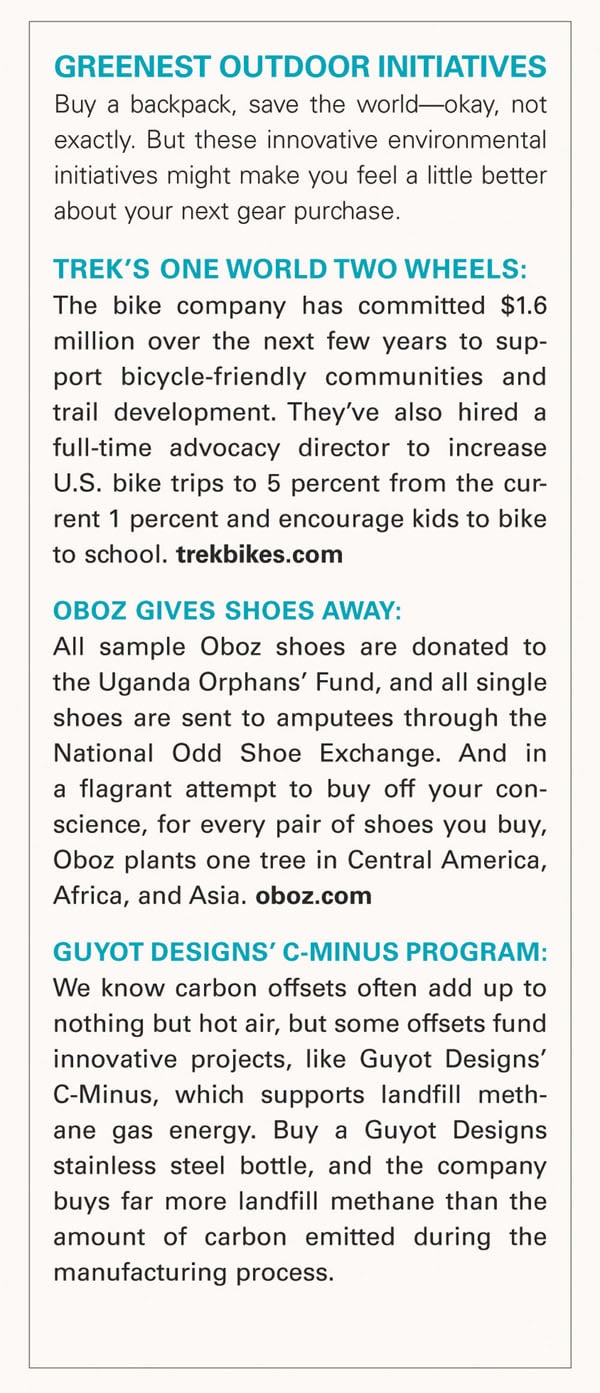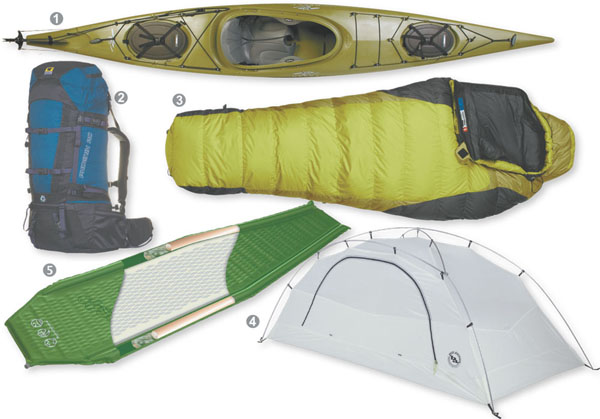No Greenwashing Here—These Environmentally Conscious Outdoor Companies Walk the Eco-Talk

Greenest Outdoor Companies
No company is perfect. You can’t produce something and not have some impact on the environment. But a few forward-thinking outdoor companies have gone beyond the standard carbon offset to instill real change in the way they do business.
1. Patagonia
Patagonia doesn’t join environmental initiatives—it starts them. The much-hyped 1% for the Planet is its most popular initiative, but over the years it has given $31 million in grants and donations to nonprofits through its enviro-grants program. Patagonia also founded Conservation Alliance, a coalition of 155 outdoor companies that has given more than $7 million to grassroots conservation efforts.
Patagonia built a solar plant at their headquarters and pioneered the use of recycled materials in their clothing. Recently, Patagonia launched the Footprint Chronicles, a website that allows you to track the impact of specific Patagonia products from design to delivery. Take part in the company’s Common Threads Program and recycle your old fleece or cotton, and you can watch the footprint of that jacket shrink a little. Patagonia employees can leave their job to assist an environmental group of their choice, and still get paid by Patagonia. To date, more than 750 employees have taken part in the internship.
2. Clif Bar
Clif Bar is 70% organic, uses recycled materials in packaging, and has eliminated shrink wrap, which saves 90,000 pounds of plastic per year. Employees enjoy the Cool Commute Program, which encourages staff to practice alternative commutes. Putting their money where their mouth is, Clif Bar has financed the construction of 13 farmer-owned wind turbines. Also impressive is their Two Mile Challenge, which encourages customers to replace one trip a week under two miles with a bike. Participants have offset 70,896 pounds of carbon so far.
3. Osprey
This small, independent backpack company is quietly becoming a leader in green design, largely because of their use of more recyclable materials in their packs every year. Their Resource Series of packs uses 86 percent recycled materials. Osprey offers cash incentives for employees who carpool or use non-motorized transportation. Their headquarters is powered by renewable energy, and they’ve recently installed waterless urinals. It sounds like a small step, but it saves 19,000 gallons of water a year.
4. Organic Climbing
This climber-owned manufacturer of bouldering crash pads mostly sells directly to consumers in an attempt to focus on quality while eliminating the bulk of their greenhouse gas emissions. The durable, long-lasting pads are stuffed with soy-based and PVC-free foam, and the customized patterns are sewn from colorful scraps found on the cutting room floor. All manufacturing is done in-house: the Montana headquarters is 100% wind powered and all materials are made in the U.S. At the end of the week, Organic Climbing only throws away one household garbage bag.

We’re anxiously awaiting the hemp bicycle that sucks carbon out of the air as you pedal. In the meantime, assuage your eco-guilt with these greener gear choices.
1. Necky Looksha 14
This touring kayak is made with 100 percent post-industrial recycled plastic that Necky scavenged from their own manufacturing floor. The company claims the recycled plastic actually has stronger properties than the regular plastic. As a bonus, 1 percent of all gross sales from the Looksha 14 are donated to the Waterkeeper Alliance.
$1429; neckykayaks.com
2. Mountainsmith Phoenix Pack
You’ve probably been wearing Mountainsmith’s lumbar packs for years, but their new recycled Phoenix may entice you to try out something larger. The 4211 cubic inch behemoth is made from 100 percent recycled PET fabric, sustainable bio-polymer buckles, even recycled zippers and webbing. And Mountainsmith has also retooled their classic Tour lumbar pack with recycled PET as well.
$289; mountainsmith.com
3. The North Face Green Kazoo
The shell and lining of this 15-degree bag are made from 100 percent recycled fabrics (water bottles, garment fabrics, factory yarn) while the insulation is 600-fill Eastern European goose down with recycled synthetic fill compression pads. The end result is a sleeping bag that reduces energy consumption by 84 percent and carbon emissions by 77 percent.
$279; thenorthface.com
4. Big Agnes Salt Creek 2
GI Joe’s nemesis “Cobra” would feel at home in the Salt Creek 2 because of its pale color, but you’ll dig the white fabric because it’s completely dye-free. More importantly, the body, mesh, floor, and zipper are all made from 100% recycled materials. The three-season Salt Creek 2 is the poster child of Big Agnes’ Re-Routt collection, which focuses on recycled materials in a growing line of products.
$349.95; bigagnes.com
5. pacific Outdoor Equipment Peak Oyl Lite
The Peak Oyl Lite is the lightest full-length, one-inch pad on the market. It also happens to be the most environmentally friendly inflator pad you can buy. POE used 100% recycled fabrics for the shell (even the valve is recycled) but went a step further and created a new foam core derived from renewable palm oil, replacing a significant portion of the petroleum that goes into traditional pads. And palm oil isn’t a food-replacement crop like other bio-plastics, so you don’t have to worry about starving third world countries.
$85; pacoutdoor.com
(not Shown) Atayne POV
That polyester performance T you’re wearing right now is made from petroleum and treated with harsh chemicals. The performance T made by Virginia-based Atayne is made from trash (recycled plastic bottles and coconut shells) and isn’t treated with any unsustainable chemicals or dyes. Plus, it advertises the Four R’s: Reduce, Reuse, Recycle, Run. Look for Atayne’s “Take Back” program, where you can give up your old oil-based wicking shirt for a $5 credit toward a friendlier Atayne (the company will recycle all shirts donated).
$38; atayne.com







